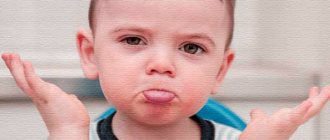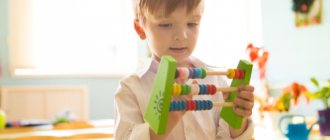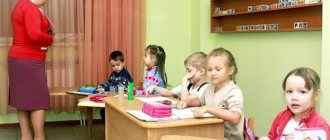Features of development at 7 months
In the second half of the year, the baby takes leaps and bounds to master the world around him at a qualitatively new level, based on higher psychophysical capabilities along all leading lines of development (sensory, social, speech, motor, etc.).
It is significant that the baby masters crawling. He begins to move independently in space. Crawling is one of the basic human movements, along with walking, running and climbing. This is the first of all the basic movements, and it is this that the child masters at 7 months.
Crawling helps strengthen the vestibular apparatus, the ability to navigate in space, and activates the baby’s metabolism, growth and development. By the end of the 7th month, the baby begins to crawl for a long time and in different directions.
Mastering this skill by the baby takes mother and child to a new level of communication, in which the adult begins to act as a partner, but for this the mother must create certain conditions.
Firstly, as soon as the baby has moved from crawling on his arms (at 6 months) to crawling, the mother chooses the most comfortable place in the room, laying a carpet or a large blanket on the floor. Here the child will learn a new skill. It’s good if this space is somehow fenced off: with a wall, chairs, etc. And, of course, it should be safe: no sharp corners, objects falling from above, open sockets, gaps, cracks into which a baby can stick a finger.
Secondly, the adult’s location in this new space matters. To communicate with the baby, the mother is recommended to sit on her lap. It is important to be in a position not “above”, but “next to” the child, because standing above the baby, the adult is so far from him in the literal sense of the word that the baby can neither see, nor hear, nor respond to words, nor imitate the adult facially and vocally. In this case, the child is in a so-called “social vacuum”. Therefore, it is important that the adult sits on the floor and his face is at the level of the baby’s face.
At the 7th month, the baby develops a social need for an adult who communicates with him in a “businesslike” manner, plays, revealing to the baby more and more new properties of surrounding objects and toys. The baby begins to feel attached to the one who is next to him. We can say that this is a key point in their further communication, including verbal communication. The baby seems to peer into a close adult, who becomes more understandable to him in emotions, facial expressions, gestures, words, movements, actions, and whom the child begins to imitate.
Having mastered crawling, the baby acts independently: he chooses the goal of movement, sets the pace of movement and changes direction, fulfilling his desires: for example, to get a toy, see the source of a sound, get closer to his mother, see what is in the box or where the ball rolled.
The bright objects and toys surrounding the baby encourage him to crawl through the space in order to take possession of them. The mother is next to the child on the carpet. She organizes games with balls, rings, cubes, animal toys, and shows actions with objects - rolling, rolling, pushing, stringing, laying out, folding, etc.
The child’s hands become more skillful, he moves from 1-2 actions to a manipulative game, consisting of a chain of simple but interconnected movements of an introductory nature. Subject activity begins to play a strategically important role in the child’s overall development and the formation of speech skills.
Speech delay
If a child of 1-2 years old does not speak, it is too early to worry, says Evgeny Komarovsky.
The age at which you need to take your lack of speech seriously is 3 years. At the same time, parents must clearly formulate for themselves and for their doctor exactly how the baby is silent: he does not understand adults or does not speak, but understands everything.
Often the baby speaks, but adults do not understand him, because he mumbles something incomprehensible, does not memorize the names of objects, calling them in his own way in his own language, inaccessible to adults.
You can find the answer to what to do if a child does not speak in the following video from Dr. Komarovsky.
Sometimes three-year-old children speak, but are limited only to individual words, which cannot be tied into sentences or even phrases.
After mom and dad describe the essence of the problem as fully as possible, you can begin to look for the reasons for the tiny silence.
Doctors consider delayed speech development to be a condition in which there is no coherent speech at the age of three. Moreover, the presence of phrasal speech at this age is also considered a deviation from the norm, but not as significant.
According to medical statistics, speech retardation is recorded in 7-10% of children aged 3 years, and boys are much more likely to be silent than girls - for every one non-speaking girl there are 4 silent boys.
How to talk to a 7 month old baby
During object games with an adult, the baby hears the names of toys (and other objects) and actions with them. He begins to understand phrases supported by a specific gesture and remember the names of objects: “Here! Take it!”, “Crawl to me!”, “Hold the ball!” Now to the question: “Where?” The child easily finds the toy named by the adult. Being in a good mood, the baby babbles, listening to the sounds made. This is how he consolidates his newfound speech skills. At the same time, the baby “creates”, “invents” sounds. Now you hear in babbling combinations of two sounds like “eu-u”, “au-u” and three sounds like “aue”, “eaa”, etc. The baby “plays” with vowel phonemes and, as if experimenting, performs his unique vocals .
This is how the child gradually prepares to master the ability to speak.
Next, the baby begins to try to pronounce vowels in combination with consonant sounds. First you hear: “a-am”, “u-u-va”, and then “meme”, “babe”, “baba”, “nanny”, etc. This is how a “stellar” achievement of the 7th month of life arises. It should be noted that there is no semantic content in baby babble, but it becomes intonationally more expressive. At 7 months, the intonation of a request appears, which at 8 months the baby can already express quite clearly.
During this period, the practice of verbal communication between an adult and a child should be continued based on sound combinations found in the baby’s babble. Along with the question “Where?” the speech construction of the statement is introduced: “This is Cook the cockerel, and this is Ava the dog.” Then comes the question: “Where is Kuka, and where is Ava?” The baby is already able to choose the named item from two.
By setting the task of developing speech understanding, an adult expands the child’s knowledge about the world around him by organizing observations during a walk. In the city, the mother draws the baby’s attention to a flock of sparrows swimming in a spring puddle, or a cat basking in the rays of the bright sun. In the summer, at the dacha, if possible, the child should be shown a cockerel, a hen, chickens, a goat, a lamb. Acquaintance is necessarily accompanied by imitation of sounds made by animals (“Oink-oink”, “Moo-oo-oo”). The summer period of a child’s life at the dacha enriches him with impressions, which will then be included in surprise shows and play folklore stories.
At 7 months it’s time for finger games. First, the mother shows the baby a game with her palms in such games as “Ladushki”, “Hello - Goodbye”, “Forty-Forty”, etc. In this case, the sound and intonation expressiveness of poetic folklore is widely used.
The 7th month poses new tasks, the implementation of which is necessary for the overall development of the baby, and it largely determines the formation of speech skills. Necessary:
- provide the child with sufficient play space to master crawling;
- practice simple joint games with your child. For example, an adult strings rings, and the baby takes them off, or a mother collects balls in a bowl - the baby scatters them, etc.;
- enrich the child emotionally in the process of “business” communication, encouraging his activity and initiative;
- encourage the baby to develop imitative gestures and sounds; improve the perception of objects. For this purpose, show the child large toys of different colors and sizes (25-35 cm) from a distance of 1-2 m or more. Develop color vision by selecting toys according to the colors of the rainbow - red, orange, yellow, green, blue, indigo, violet.
To develop the baby’s capabilities in understanding adult speech and activating his own, it is recommended:
- expand familiarity with the outside world;
- when communicating with a child in various situations, intensively use speech as a means of communication and cognition;
- continue to develop the speech apparatus, encouraging the baby to make vivid vocalizations - pronouncing clear vowels, drawn-out sounds (humming) and babbling (simple syllables like “va-va-va” or “bu-u-u”, etc.);
- stimulate the development of phonemic hearing - the ability to listen to speech.
The child still, along with “conversations,” needs a “silence mode,” when the baby “creates” sounds, listening attentively to what he says. The question “where?” should be introduced into communication more often; the answer to it can be a pointing gesture.
At this stage of speech development, two types of classes are carried out with the baby: purely speech, when articulation is practiced, and play, where they learn some actions with toys, accompanied by the speech of an adult.
During classes, it is still recommended to take part in a roll call with the baby based on the speech reactions the baby has. An adult helps the child understand the encouraging, negative or neutral intonations of speech addressed to him.
The baby responds to his name, but now he also assimilates derivatives of it in an affectionate diminutive meaning. This is facilitated by songs, sayings, pestles, in which the child’s name is pronounced in different speech variations (for example, Slava, Slavik, Slavochka, Slavulka, Slavchik, Slavulya, Slavenka, etc.).
Parents themselves can compose a song expressing love and affection, in which the baby’s name will sound.
How to teach to speak
If the cause of delayed speech development is organic (hearing diseases, neurological abnormalities, pathologies of the speech apparatus or speech center of the brain), then Komarovsky advises starting with eliminating this cause.
The child should be prescribed adequate treatment depending on the diagnosis. In parallel with this, the doctor will definitely give recommendations on how to conduct classes for speech development.
If the reason for the child’s silence lies in social, pedagogical or psychological problems, factors that prevent the child from expressing his thoughts through speech should also be eliminated.
Dr. Komarovsky will talk about how to help a child learn to talk in the next video.
Evgeny Komarovsky argues that sometimes it is enough to send a three-year-old with an acute lack of communication in the family to kindergarten. In a children's group, many boys and girls learn to speak much faster than in the company of adults.
Parents who decide to develop the speech of a three-year-old child in the absence of diseases that caused silence, must independently prepare for a slow and labor-intensive process. A child psychologist or child psychotherapist can help them with this, if there is such a specialist in your city. The key to success lies 70% in the efforts and efforts of parents.
Examples of games and activities at 7 months
Danilka
Danechka - Danilka, You are my raspberry, Danechka - Danichek, I’ll give you a gingerbread! Danya-Danya-Daniil, the little bunny asked Danya: “Say “A-lu-lu!” “A-lu-lu-lu!” I'll share a carrot with you! I love Danechka!” (L. Pavlova) Valechka Valechka-Valyusha, Don’t be a screamer! Valechka - Valyusha, Say: “A-gu-gu-gu!” A goose is grazing in the meadow, He heard: “A-gu-gu-gu!” And he said: “I won’t run away!” (L. Pavlova) Sveta-Svetochka, Green twig, Light fluff, White snowflake! Svetochka-Sveta, Girl of Light! (L. Pavlova)
Calling the child by name, the adult looks into his eyes, smiles, gently touches his hands, and strokes his head.
When conducting games and activities with a baby who is not yet sitting, an adult takes this feature into account. Purely speech classes, where the mother engages in roll call with the baby, encourages the repetition of a familiar syllable (“ma”, “mu”, “li”, “gu”, etc.), shows the articulation of sounds, should be carried out with the baby lying on the back, facing an adult. The child should clearly see the speaker's face. The baby can be placed on a changing table, on the carpet or on mother’s lap, half-sitting, supported by an adult’s hand.
After speech exercises, the mother shows the child toys, plays with his hands and feet (nurturing), sings a song or reads a nursery rhyme or a fable.
Sample speech lesson “Poppy for Masha”
Task
Activate babbling and introduce the sound combination “ma” into the baby’s speech practice.
Material
Medium size doll (25-30 cm).
Content
The mother places the baby on the changing table. Calls you by name affectionately.
Then he invites the baby to roll call, showing the articulation of the sound combination “ma,” pauses for 10-15 seconds and repeats: “Ma-ma-ma!” If the baby responds, the adult continues the “dialogue,” allowing the baby to fully demonstrate his vocal capabilities. As soon as the baby falls silent, the adult again encourages him to interact verbally, repeating the syllable “ma-ma-ma.”
Then the mother shows the baby the doll and calls it by name: “Ma-a-sha”, “Ma-a-sha, little one!” Then he asks: “Where is Ma-a-sha?” And he answers: “Here is Ma-a-sha!”
Reads a poem (a nursery rhyme), where the desired syllable is repeated several times and is stressed:
For Ma-shenka, For little Ma-a-k Bright scarlet blossomed.
The mother turns the baby onto his tummy and places him on the carpet, placing a doll in front of him, thereby encouraging the baby to crawl. While playing with the child, she repeats a poem about Mashenka, she can sing it or recite it. Then you can show a scene with a doll: for example, how it walks or dances.
An approximate situation of speech communication “Hide and seek”
Tasks
Expand the child's social communication. Cultivate love for loved ones. Develop an understanding of adult speech, in particular, the words “mom”, “dad”, “grandmother” and others in combination with the question “where?” To consolidate and expand understanding of this issue.
Material
Two toys familiar to the baby, for example, Bunny and Cook's cockerel.
Content
The adult hides a toy that the child is accustomed to looking for in a constant place, for example, a cockerel Kuku.
He hides Bunny in another place in the same way. Then he turns to the baby with the question: “Where is Cook’s cockerel?” Not finding the toy in its usual place, the child is surprised. “Kuka hid! Let's go look. Kuka, where are you? - asks mom. She takes the baby in her arms and they begin searching for the toy. The adult accompanies his actions by repeating the question: “Where is Cook?” Finally the cockerel was found. An emotional scene of a meeting with the cockerel Kuka is played out. The toy is put in place. A similar game happens with Bunny.
Then the mother expands the meaning of the question “where?”, inviting the baby to look where grandma is. She takes the child in her arms, the search for the grandmother begins: “Baba, where are you?” (Grandma hid behind a door, curtain, chair, etc.).
Mom emotionally plays out the search and the moment of finding her grandmother. This scene is accompanied by laughter and joyful communication. The grandmother caresses the baby, hums some funny nursery rhyme:
Ay, kachi-kachi-kochi! Let's bake some rolls, the rolls are hot! Get out of the oven! (Russian nursery rhyme)
At this moment, mom hides unnoticed. The plot is repeated with the participation of a second adult family member: “Where is mom? Mom, where are you? The search is accompanied by bright game moments and positive emotions:
Ay, okay, okay! Ladushki - palms! We play ladushki, we amuse Baby (child’s name)! (Russian nursery rhyme)
If the baby is not tired, the grandmother hides again. Again the question sounds: “Baba, where are you? Where is grandma? The game repeats itself. Its peculiarity is “surprise”, unexpectedness, when the question “where?” is combined with a result-answer that is understandable to the child: “That’s where!” Found!"
An approximate finger game for developing speech understanding “Our Hands”
Task
With your child, learn hand movements performed to the song (or speech) of an adult.
Content
The mother plays with the child’s hands: with slight movements, turning and waving one or the other palm. Sings:
Our hands are birds, sparrows, titmice! (g times) The child’s arms rise, touch his head. K-shi... Let's fly! They sat on their heads! Like this, like this, they sat on their heads! (The song is performed to the tune of “Bayu-bayushka” cheerfully, at a fast pace).
Sample lesson on understanding the names of objects “What is this?”
Tasks
Create situations that can interest the child and encourage him to babble and vocalize. Help you remember the names of familiar toys (cockerel, bunny, bell, drum). Develop crawling.
Material
Toys (2-3 pcs.) Napkins.
Content
The mother places toys on the carpet at some distance from the baby and covers them with napkins.
Then he encourages the child to crawl to the toy, asking: “What’s there?” The kid pulls off the napkin and discovers an object. Mom names the toy, for example: “This is Cook’s cockerel” or “This is Masha’s doll.” So the baby sequentially opens all the toys. He repeatedly hears interrogative speech structures: “What’s there?”, “What’s that?” - and the answer: “This is Kuka,” “This is Masha.” Next, the toys discovered by the baby are used in the game.
A purely speech lesson with a child can last 2-3 minutes. Lesson using toys, demonstrations and physical activity - 6 min.
Baby's achievements at 7 months
If the child was given sufficient attention and the age-related characteristics of pre-speech development were taken into account, then by the end of the 7th month he will delight you with his successes:
- The baby babbles for a long time. He is able to repeatedly pronounce 2-3 identical syllables.
- Enters into a roll call with an adult if he is encouraged to do so.
- Understands the intonations of an adult’s speech, reacts differently to the joyful and sad notes of his voice.
- Responds emotionally to speech.
- To the question “where?” points with a finger at familiar toys located in the same place.










